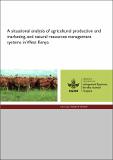| dc.description.abstract | The Western and Nyanza provinces that make up the West Kenya Humidtropics action site
form part of the 20% arable land in Kenya. The region is characterized by high agricultural
potential coupled with high population density, extensive land fragmentation and
degradation (Crowley and Carter 2000). The main agro-ecological zones (AEZs) range from
Upper Midland (UM) to Lower Midland (LM); from 1000 to 2000 m above sea level in
altitude. Kisii, Nyamira, Bungoma, Kakamega and Vihiga districts cover Upper Midland
(UM1) and Lower Highland (LH1 and LH2) AEZs. Homa Bay, Rachuonyo, Migori, Kuria and
Transmara occupy Lower Midland (LM1–LM5) while Kisumu and Nyando cover LM1-LM4.
Rainfall varies from the lows of 900 mm in parts of Siaya and Kisumu to highs of 2000 mm in
UM and LH AEZs of Kisii, Nyamira, Butere-Mumias and Kakamega among others … | en_US |

